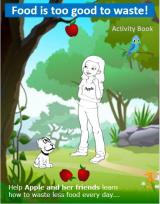Tools for Preventing and Diverting Wasted Food
On this page:
- Excess Food Opportunities Map
- Why Assess Wasted Food?
- Food Loss Prevention Options for K-12 Schools, Manufacturers, Restaurants, Universities and Grocery Stores
- Waste Reduction Model (WARM)
- Managing and Transforming Waste Streams: A Tool for Communities
- Reducing Food Waste Activity Book
- Webinars Covering Sustainable Management of Food Topics
- Peer-to-Peer Exchanges
Excess Food Opportunities Map
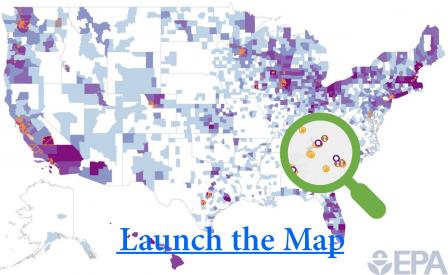 The interactive Excess Food Opportunities Map supports nationwide diversion of excess food from landfills. The map, updated to Version 2.1 in April 2020, displays the locations of nearly 1.2 million potential industrial, commercial and institutional excess food generators and about 5,000 potential recipients. The map also provides establishment-level information including estimates of excess food generation. Use this map to:
The interactive Excess Food Opportunities Map supports nationwide diversion of excess food from landfills. The map, updated to Version 2.1 in April 2020, displays the locations of nearly 1.2 million potential industrial, commercial and institutional excess food generators and about 5,000 potential recipients. The map also provides establishment-level information including estimates of excess food generation. Use this map to:
- Inform food waste management decisions at the local level.
- Identify potential sources of food for rescue and reuse.
- Identify potential feedstocks for compost, anaerobic digestion, or other excess food recyclers.
- Identify potential infrastructure gaps for managing excess food.
- Identify alternatives to sending excess food to landfills.
Why Assess Wasted Food?
The first step in reducing wasted food is to measure it. A wasted food audit serves as the foundation for reduction efforts. By using EPA's wasted food assessment tools, food service establishments can:
- Save money by reducing over-purchasing and disposal costs
- Reduce environmental impacts
- Support efforts to eliminate hunger
- Increase tax benefits by donating food; and
- Support community waste reduction efforts.
EPA provides a variety of wasted food assessment tools for a food service establishment’s unique circumstances. Those just starting to consider measuring and tracking their wasted food may want to begin by conducting a baseline assessment with the Food Waste Assessment Guidebook, as it takes minimal labor and time to complete. Those seeking to achieve the highest cost savings and largest waste reductions may find that daily tracking of wasted food and/or packaging with EPA’s Toolkit for Reducing Wasted Food & Packaging or with simple Paper Tracking Waste Logs better suits their waste reduction goals.
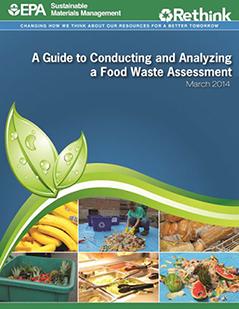 Food Waste Assessment Guidebook
Food Waste Assessment Guidebook
One way to identify what types of food and how much is being wasted is to perform an assessment of waste once it has already been thrown out.
Retail, food service, and other food management establishments can use the Food Waste Assessment Guidebook to learn how to take a "snapshot in time" of their wasted food by either manually sorting through materials in a garbage sample or by visually observing and estimating waste.
A Guide to Conducting Student Food Waste Audits: A Resource for Schools
The U.S. Environmental Protection Agency, the U.S. Department of Agriculture, and the University of Arkansas collaborated to create a guide for students and school personnel about the amount of food wasted in their cafeterias. The guide provides information on why and how to do a food waste audit, what to do with the data collected, and also offers food waste prevention ideas.
Toolkit for Reducing Wasted Food and Packaging
![]() Information on the reason for waste such as over-preparation or improper cooking is important to collect in order to make meaningful changes. Food service establishments can use this tool to track the daily amount, type of, and reason for wasted food and packaging. Users enter information into the Food and Packaging Waste Prevention Tool (XLSM)(9 pp, 914 K,
March 2014)
which automatically creates graphs and data summaries to help identify patterns of waste generation. Based on these patterns, a business can make strategic changes to its operation to maximize waste reductions and cost savings. Note: After clicking on the link for this tool, select "Save" instead of "Open" to ensure your browser opens this tool with the right program.
Information on the reason for waste such as over-preparation or improper cooking is important to collect in order to make meaningful changes. Food service establishments can use this tool to track the daily amount, type of, and reason for wasted food and packaging. Users enter information into the Food and Packaging Waste Prevention Tool (XLSM)(9 pp, 914 K,
March 2014)
which automatically creates graphs and data summaries to help identify patterns of waste generation. Based on these patterns, a business can make strategic changes to its operation to maximize waste reductions and cost savings. Note: After clicking on the link for this tool, select "Save" instead of "Open" to ensure your browser opens this tool with the right program.
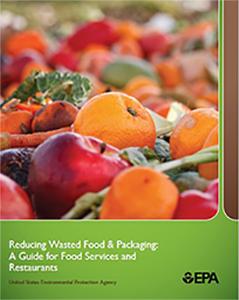 An accompanying guide, the Reducing Wasted Food & Packaging: A Guide for Food Services and Restaurants provides source reduction strategies and case studies of food service establishments turning audit results into actions to successfully prevent wasted food.
An accompanying guide, the Reducing Wasted Food & Packaging: A Guide for Food Services and Restaurants provides source reduction strategies and case studies of food service establishments turning audit results into actions to successfully prevent wasted food.
EPA also offers an online training in using this resource – see the Sustainable Materials Management (SMM) Web Academy Webinar Series, A Step-by-Step Guide to Conducting a Wasted Food Assessment with the Reducing Wasted Food & Packaging Toolkit.
Note: The tool requires a minimum of two weeks of daily tracking by staff and weekly data entry for best results.
Paper Tracking Waste Logs
Paper Tracking Waste Logs can be printed and used to track the quantity and reason for waste.
![]()
Food Loss Prevention Options for K-12 Schools, Manufacturers, Restaurants, Universities and Grocery Stores
Businesses and organizations can learn to effectively prevent wasted food by taking source reduction steps such as inventorying supplies, changing processes and buying less. EPA developed tip sheets for K-12 schools, food manufacturers, restaurants, universities and grocery stores that provide suggestions for ways these sectors can prevent food loss and waste.
Waste Reduction Model
The Waste Reduction Model (WARM) tool helps organizations track and voluntarily report greenhouse gas emissions reductions from several different waste management practices. In the example illustrated below, a food service establishment estimates the greenhouse gas savings associated with decreasing the amount of bread and produce landfilled.
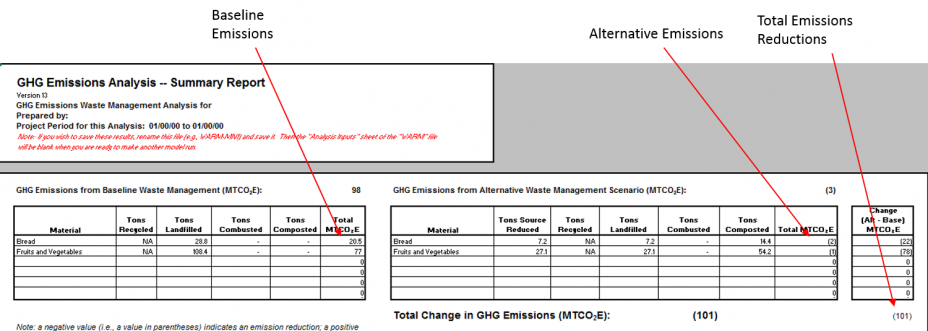
For the full example, see the SMM Web Academy presentation "Measuring Food Waste and Packaging Impacts in WARM".
Managing and Transforming Waste Streams Tool
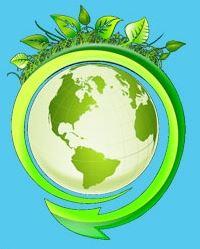 The Managing and Transforming Waste Streams Tool features a table of 100 measures communities can employ to reduce waste and recover materials. By using interactive functions (sorting, searching and/or filtering), local planners can explore best practices in the form of ordinances, policies, programs, contracts, outreach and technical assistance, and infrastructure development, with the objective of creating a list of strategies tailored to their community's needs and capabilities.
The Managing and Transforming Waste Streams Tool features a table of 100 measures communities can employ to reduce waste and recover materials. By using interactive functions (sorting, searching and/or filtering), local planners can explore best practices in the form of ordinances, policies, programs, contracts, outreach and technical assistance, and infrastructure development, with the objective of creating a list of strategies tailored to their community's needs and capabilities.
The tool also includes over 300 implementation examples from communities across the United States, including links to local ordinances and program websites, as well as model language for amending service provider contracts or franchise agreements The measures and implementation examples capture nuances in approaches local governments can take and illustrate opportunities to phase in more stringent practices over time.
Reducing Food Waste Activity Book
Help Apple and her friends learn how to reduce food waste and help protect the environment. Suitable for grades 3-5.
Training Webinars
EPA hosts webinars designed to provide useful information to Food Recovery Challenge (FRC) participants and endorsers and to others interested in learning about sustainable management of food. Experts from across the nation offer technical assistance and insight into various food recovery-related topics and best management practices to support the work of various sectors of the FRC, such as grocers, venues, universities, and the hospitality industry.
Peer-to-Peer Exchange Webinars
The purpose of the Peer-to-Peer Exchange Webinars is for current and potential Food Recovery Challenge participants to learn from the speakers and from each other about how to successfully achieve wasted food reductions, as well as identifying obstacles, and learning useful strategies on how to overcome obstacles. Below is more information about our last peer to peer exchange. Click on the topic title to access a recording of the session.
| Date | Topic | Speakers |
|---|---|---|
| June 15, 2016 | Peer-to-Peer Exchange on Reducing Wasted Food in Educational Institutions Exit |
Rebecca Hunt, Dietitian and Marketing Manager for Dining Services at Keene State College, Sodexo Heather Greenwood, Campus Sustainable Material Management Specialist, Keene State College Mindy Jaffe, Resource Recovery Specialist, Lanikai Elementary School |
| June 14, 2017 | Peer-to-Peer Exchange on Reducing Wasted Food in Restaurants and by Food Service ProvidersExit |
Ted Monk, Vice President of Sustainability and Corporate Responsibility for Sodexo North America Katie Rose, Co-Owner, Goodkind Restaurant Melissa Tashjian, President, Compost Crusaders |

